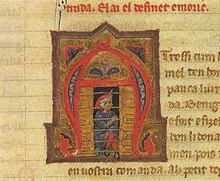|
Bertolome Zorzi Bertolome Zorzi[1] (Latin: Bartolomeus Gorgis; fl. 1266–1273[2]) was a Venetian nobleman, merchant, and troubadour. Like all Lombard troubadours, he composed in the Occitan language. Eighteen of his works survive.[3] According to his vida, while travelling with a large band of merchants to the Byzantine Empire, they were captured by the Republic of Genoa, which was then at war with the Republic of Venice, and taken prisoner to Genoa.[4] There Zorzi composed many songs from prison and even collaborated on some tensos with Bonifaci Calvo, a native Genoese troubadour.[4] In response to a sirventes in which Bonifaci blamed the Genoese for allowing the Venetians to gain the upper hand and insult them, Zorzi composed the sirventes Molt me sui fort d'un chant merveillatz ("I was very much surprised by a song") justifying Venice. The response convinced Bonifaci and the two became friends.[5] Upon the release of the prisoners when Venice and Genoa came to terms of peace (about seven years later),[5] Bertolome returned to Venice and was rewarded by the Doge with the castellanies of Coron and Modon in the southwestern Morea.[4] According to his vida, there he fell in love with a beautiful local noblewoman and spent the rest of his life.[4] Zorzi wrote a sestina entitled En tal dezir mos cors intra that alludes to the Perceval of Arthurian legend confessing to his uncle.[6] Zorzi also has been cited as one of several troubadours who protested Alfonso X's refusal to rescue his brother the infante Henry from an Italian prison.[7] In Mout fai sobrieira foli, each stanza of Zorzi's ends with a corresponding quotation from Peire Vidal's Quant hom es en autrui poder, whom he is defending from those who label him a "fool".[8] Example An example of Zorzi's use of metaphor:
NotesSources
|